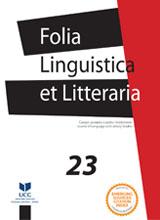MEĐUSOBNA POVEZANOST TEKSTOVA: MITSKO ZALEĐE I ARHETIPSKA SIMBOLIKA E.S.
THE SHAPING OF A TEXT'S MEANING BY ANOTHER TEXT: MYTHICAL HINTERLAND AND ARCHETYPAL SYMBOLISM OF E. S.
Author(s): Dragana Kršenković BrkovićSubject(s): Serbian Literature, Theory of Literature
Published by: Filološki fakultet, Nikšić
Keywords: intertextuality; Danilo Kiš; Eduard Sam; mischief; jester; fool; archetypal symbolism; mythical hinterland;
Summary/Abstract: „Any text is the absorption and transformation of another one“, argues Julia Kristeva. Her ideas on intertextuality have influenced many literary theorists during the 20th and 21st century. This paper demonstrates in what way Danilo Kiš has established an intertextual relationship between Eduard Sam (a character from Rani Jadi) and ancient literary characters, such as a mischief, a jester, and a fool. The paper explores how Kiš inscribed a rich tradition of such ancient, archetypal characters into Eduard Sam. This tradition originated in the pre-agricultural society; thus a mischief, a jester and a fool work as ancient mythical models. It can also be traced back to Rabelais’s realistic fiction in his satirical novel The Life of Gargantua and of Pantagruel (where a mischief, a jester and a fool, represented by Gargantua and his son Pantagruel, become shaped by periodical, carnivalesque and mythological motives). The paper looks at Bakhtin’s interpretation of Rabelais’s work and discusses the folk culture of the Middle Ages and the Renaissance (especially archetypal symbolism of the Rabelais’s characters).
Journal: Folia Linguistica et Litteraria
- Issue Year: 2018
- Issue No: 23
- Page Range: 91-108
- Page Count: 18
- Language: Serbian

